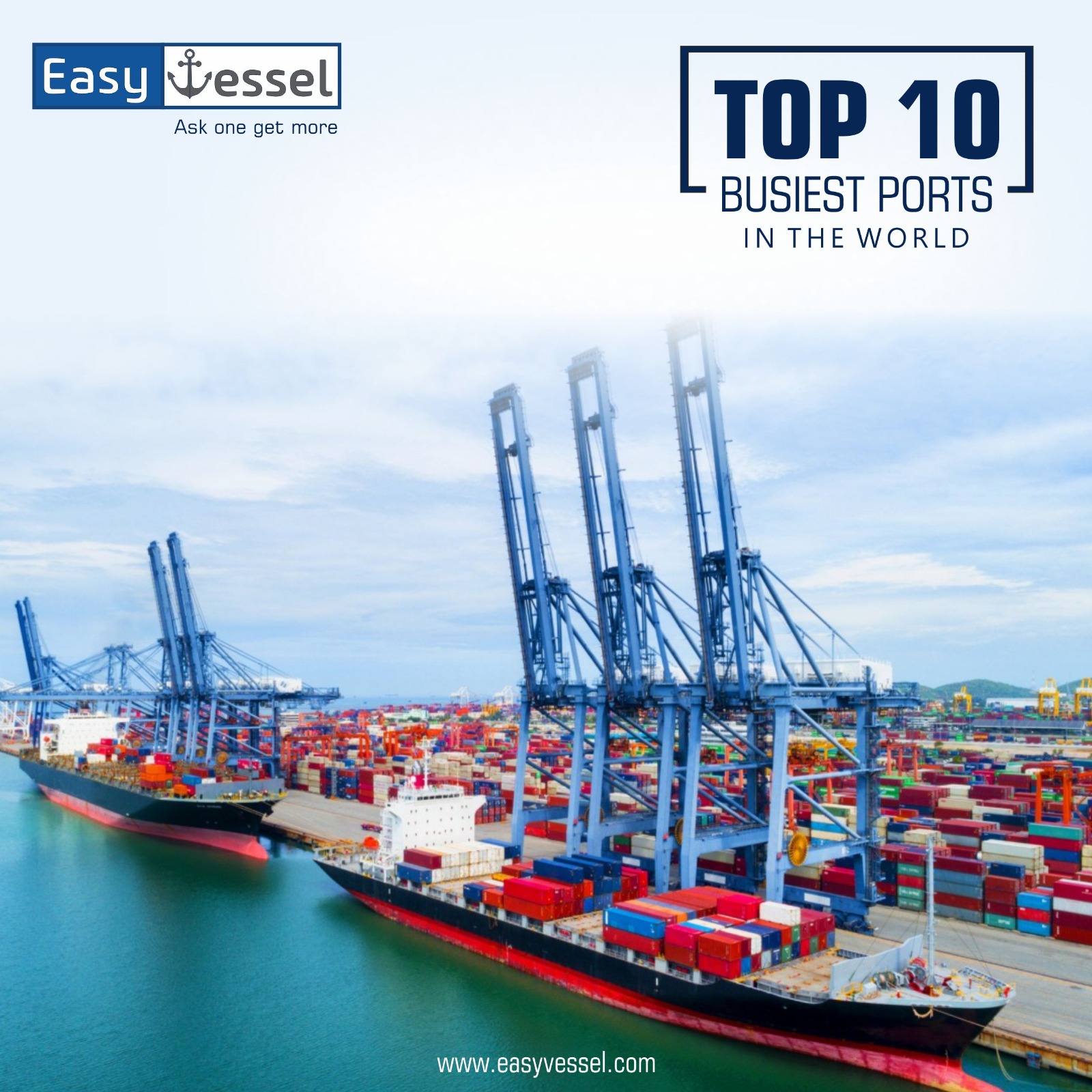- In today’s interconnected world, international trade forms the backbone of the global economy in the busiest ports in the world.
- Central to this huge network, are the world’s top 10 busiest ports in the World.
- These maritime gateways play a crucial role in shaping economies and industries by facilitating the movement of goods on an unprecedented scale.
- The busiest ports in the world are vital hubs for international trade, handling billions of tons of cargo each year.
- The busiest ports in the world are located in some of the world’s most important economic and trade.
- In today’s interconnected world, international trade forms the backbone of the global economy in the busiest ports in the world.
- The size and activity level of a port determines its importance.
- The best way to assess the importance of a port is to look at both its size and its busiest ports.
Top 10 Busiest Ports in the World
Here are the top 10 busiest ports in the world based on the number of twenty-foot equivalent units (TEUs) handled:
- Port of Shanghai, China
- Port of Singapore, Singapore
- Port of Ningbo-Zhoushan, China
- Port of Shenzhen, China
- Port of Busan, South Korea
- Port of Qingdao, China
- Port of Hong Kong
- Port of Tianjin, China
- Port of Rotterdam, The Netherlands
- Port of Guangzhou, China
Port of Shanghai, China
- Shanghai Port is the world’s largest and busiest port, located near the Yangtze River in China.
- It has been operational for over 180 years and surpassed Singapore as the largest port in 2010.
- Situated in Shanghai, China, it is the world’s largest port, overtaking the Port of Singapore.
- Shanghai Port has five operational areas and handles around 29 million TEUs (twenty-foot equivalent units) of cargo yearly.
- This port plays a crucial role in the economic development of regions like Zhejiang, Jiangsu, and Henan along the Yangtze River.
- It a handling capacity of 744 million tonnes, this port can efficiently manage up to 32.5 million standard-sized TEU containers.
- These areas collectively house 125 berths, with approximately twenty kilometers of quayside space.
- This port is crucial for China’s international trade, simplifying a quarter of the country’s total trade volume.
- On average, It handles 26% of China’s international trade with 19 terminals, 125 piers, and over 2,000 container ships monthly.
Port of Singapore, Singapore
- The Port of Singapore is a global hub due to its strategic location at the crossroads of major shipping routes, connecting East and West.
- It’s a crucial gateway for goods flowing between Asia, Europe, and the Americas.
- It’s renowned for being a transshipment hub, with nearly 80% of its transactions involving cargo bound for other destinations.
- It’s connected to over 600 ports in 120 countries and can handle vessels of various sizes.
- The port handles about 537.6 million tonnes of cargo annually and receives around 140,000 vessels each year.
- It’s also home to one of the world’s largest container terminals, consistently ranking among the top ports for container throughput.
Port of Ningbo-Zhoushan, China
- The Ningbo-Zhoushan Port, created in 2006 as a partnership between Ningbo and Zhoushan ports, is the world’s second-largest marine port.
- It has a massive cargo capacity of over 453 million tonnes and handles 15.6 million TEUs.
- With 309 berths, it connects to approximately 600 ports in 100 countries, firmly establishing itself in international trade.
- Zhoushan Port has increased its combined TEU capacity to an impressive 16.83 million, further enhancing its global maritime position.
Port of Shenzhen, China
- The Port of Shenzhen is a major global seaport, ranking as the fourth-largest globally and the third-largest in China.
- In 2020, it managed a remarkable 26.5 million containers measured in TEUs (twenty-foot equivalent units).
- Shenzhen Port covers a large area with multiple smaller ports along Shenzhen City’s coast.
- Shenzhen Port is a hub for global transportation companies, many of which have established their storage facilities there.
- It’s a hub for global transportation companies and headquarters for major corporations like Tencent and Huawei.
- Located in Guangdong province in the Pearl River Delta, the port has a substantial annual transshipment capacity of 194.9 million tons and handles 18.91 million TEUs.
- It efficiently manages an average of 75,000 TEUs in daily container transfers.
Port of Busan, South Korea
- The Port of Busan, located in South Korea’s city of Busan, is the country’s largest port and the sixth busiest container port globally.
- It also holds the title of being the largest transshipment port in Northeast Asia.
- This port is a crucial gateway for various types of cargo, including containers, bulk goods, and oil.
- With a history dating back to its opening in 1876, the Port of Busan has played a significant role in South Korea’s economic development.
- During the Korean War, it was a vital lifeline for the South Korean government and military.
- Situated in Busan, South Korea’s second-largest city, the port serves as a vital link between the Pacific Ocean and Eurasian nations.
- It encompasses four smaller ports and two terminals, facilitating trade with Japan, the United States, China, and Vietnam. Globally, it ranks as the third-largest transit port.
- The Port of Busan, often known as Pusan, has a substantial cargo-handling capacity of approximately 298 million tonnes.
- It is managed by the Busan port authority and includes key areas such as the Port of Gamcheon, Dadaepo, South Port, and North Port.
- This port handles a significant portion of South Korea’s fishery production, bulk exports, and container shipments.
Port of Qingdao, China
- The Port of Qingdao, located on the shores of the Yellow Sea in China’s Shandong Province, has a storied history dating back to the 18th century.
- It has played a crucial role in facilitating global trade in the West Pacific region.
- As one of the premier ports in the world, it maintains trade connections with more than 450 other ports in approximately 130 countries, underscoring its significance as a vital hub for international commerce.
Port of Hong Kong
- Hong Kong’s port is the region’s main gateway for global shipping and trade.
- It has nine container terminals. Despite its relatively small storage and processing area, it efficiently handles the needs of the region and connects to over 470 ports.
- Since Hong Kong is an island nation, most of its business revolves around the port, accounting for about 90% of its economic activity.
Port of Tianjin, China
- The Port of Tianjin is one of the busiest ports in the world.
- In terms of cargo traffic, it consistently ranked among the top ports globally, handling hundreds of millions of tons of cargo annually.
- Tianjin Port is the biggest and most bustling port in northern China.
- It’s a vital connection to Beijing, China’s capital, and it has a long history as one of the oldest ports in the area.
- Over time, it has grown into a crucial hub, linking up with more than 150 countries and over 600 other ports worldwide.
Port of Rotterdam, The Netherlands
- Rotterdam Port in Europe is the largest and busiest, making it unique in the top 10 busiest ports globally.
- It’s renowned for its sustainability initiatives and high trade volume.
- Rotterdam’s strong road and rail connections to other countries make it a global trade hub.
- This strategic location has driven continuous growth and development over time.
Port of Guangzhou, China
- Guangzhou Port, often called the “Silk Road on the Sea,” is a major shipping hub in southern China.
- It spans nearly 250 miles of coastline in the Pearl River Delta region.
- This port connects with over 100 ports in China and 350 ports globally.
- Guangzhou Port is crucial for both Chinese and worldwide trade.
- It comprises three primary ports along with several smaller ones.
- Notably, it boasts quay cranes reaching up to 65 meters in height, capable of serving the world’s largest container ships.
Conclusion:
- In our interconnected world, international trade drives the global economy, with ports a vital role in goods exchange.
- These maritime giants handle immense cargo volumes, shaping economies and industries worldwide.
- The world’s busiest ports, including Shanghai, Singapore, and Ningbo-Zhoushan in China, facilitate this trade on an unprecedented scale.
- Their significance lies not only in size but also in their activity level. Ports like Qingdao in China, Busan in South Korea, and Rotterdam in the Netherlands play pivotal roles in regional and global trade networks.
- Each port’s unique characteristics and strategic locations contribute to its prominence in the ever-evolving landscape of international commerce.
- Easyvessel connects you with reliable service providers for shipping needs. Sign up for access to trusted providers, simplifying the process and ensuring peace of mind. Save time and work with professionals through Easyvessel.
References:
- List of busiest container ports By Wikipedia [1].
Frequently Asked Questions
Here are the 10 busiest shipping ports in the world based on container throughput (measured in twenty-foot equivalent units or TEUs):
- Port of Shanghai, China
- Port of Singapore, Singapore
- Port of Ningbo-Zhoushan, China
- Port of Shenzhen, China
- Port of Busan, South Korea
- Port of Qingdao, China
- Port of Hong Kong
- Port of Tianjin, China
- Port of Rotterdam, The Netherlands
- Port of Guangzhou, China
Mundra is India’s busiest container port, handling around 4.4 million TEUs (Twenty-foot Equivalent Units) each year. It’s also ranked 32nd among the top 50 seaports globally. Adani Ports and SEZ Limited (APSEZ) runs this port, and it started its operations in 2001. Over time, it has grown to become India’s largest container port.
The three busiest ports in the world, based on container throughput measured in twenty-foot equivalent units (TEUs), are:
- Port of Shanghai, China
- Port of Singapore, Singapore
- Port of Ningbo-Zhoushan, China




